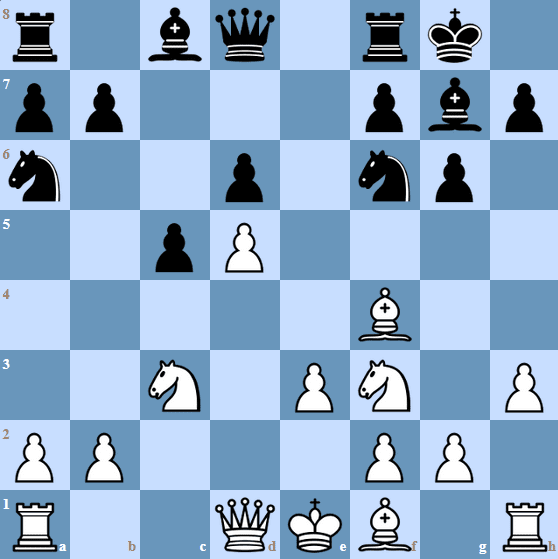There is a lot to like in a defense that allows you to counter-attack on move two!
- The tactics of the Modern Benoni often overshadow the strategic element. Do not be fooled into thinking the Modern Benoni is all about tactics.
- There is a great battle in the Benoni Defense between White’s pawn majority in the center and Black’s play on the queenside.
- The unbalanced pawn structure leads to exciting games with black counter-attacking the white center.
- White’s knight on f3 is a powerful piece, and Black will try to drive it to d2 by attacking the e4-pawn with moves like …Re8 and …f5.
- Although the black pawn on d6 is weak, attacking it is not an easy task for white. Remember, after …Re8 it is always possible to defend d6 with …Bf8
- The counter-attacking nature of Benoni Defense made it very appealing for an attacking player like Mikhail Tal.

Ideas and Strategies in the Benoni Defense
A typical opening position in the Benoni Defense is reached after 1.d4 Nf6 2.c4 c5 3.d5 e6 4.Nc3 exd5 5.cxd5 d6 6.Nf3 g6 7.e4 Bg7 8.Be2 0-0 9.0-0

The white knight on f3 is one of White’s best pieces in this position. The knight supports the e5-advance and can go to d2 if the e4-pawn needs more defenders.
Because the f3 knight is such a strong piece White will often play h3 early in the opening to prevent …Bg4.
Playing h3 early has the added benefit of keeping a black knight from attacking the white king later in the game, or harassing a white bishop on e3.
White would like to place the light-squared bishop on d3, but without a pawn on c4, the bishop can come under attack from …c4.
If the knight retreats to d2, the f3 square becomes an excellent place for the bishop. On f3, the bishop helps defend the e4-pawn and prevents moves like …Bg4 or …Ng4.
Because white has a central majority, the rooks are often well-placed on d1 and e1. Once the central pawns advance, they will free up squares for the white knights.
In many cases, black will fight for the same squares or files as the white pieces. The knight on f6 puts pressure on the e4 and d5 pawns, which the knight on c3 defends.
The rook on f8 will slide across to e8, where it applies pressure on the e4-pawn and makes it harder for the pawn to advance. Freeing up the f8 square allows Black to defend the d6-pawn with …Bf8 if needed.
Do not rush to move the bishop from g7, though, because it does a lot of good on the h8-a1 diagonal. When the knight on f6 moves, the g7-bishop places tremendous pressure on the white queenside. The bishop can also make its way to d4 and e5.
The black queenside knight can develop on d7, where it supports the knight on f6 and covers the e5-square. Another development method is Na6-c7 to help support the b5 advance and apply pressure to the d5-pawn.
Two Notable Games in the Benoni Defense
Did you know the Benoni made an appearance at the World Chess Championship Match played in 1972 between Boris Spassky and Bobby Fischer? This was round 3 of the match and it earned Bobby Fischer a victory in 41 moves!
Even Fabiano Caruana took a break from his usual super-solid opening choices and played the Benoni Defense with success, against Shakhriyar Mamemdyarov.
White Plays 6.e4
1 d4 Nf6 2 c4 c5 3 d5 e6 4 Nc3 exd5 5 cxd5 d6 6 e4

Given enough time, white will develop his pieces to their optimal squares, prevent …Bg4, and obtain an excellent position. All of this takes time, and Black can respond actively with a pawn sacrifice.
The Benoni Defense is not suitable for players who are afraid to sacrifice material!
In this line, Black is fortunate only to have to sacrifice a pawn to gain excellent counterplay.
6…g6 7 Bd3 Bg7 8 h3 0-0 9 Nf3 b5 10 Nxb5 Re8

Now the threat is to capture either the e4 or d5-pawn by using the white king in the center. If white declines to capture on b5 and chooses to safeguard the king with 10.0-0, an excellent response from black is 10…b4!
11.Nd2 allows 11.Nxd5, but after 12.Nc4 white places tremendous pressure on the d6-pawn. When a knight captures on d6, it will threaten the rook on e8, so it is best for black to strengthen his defense of d6 with 12…Re6.
White Plays 6.g3
Unsurprisingly, the fianchetto variation of the Benoni Defense is much more position in nature. White decides not to give black an object of attack and holds back on advancing the e-pawn.
Against this variation, Black does best to adopt a patient attitude and not rush into creating queenside counterplay with …a6 and …b5. Instead, a good approach is to play the excellent waiting move 9…Re8.
1.d4 Nf6 2.c4 c5 3.d5 e6 4.Nc3 exd5 5.cxd5 d6 6.g3

Black can continue in typical Benoni Defense fashion and play …g6.
6…g6 7.Bg2 Bg7 8.Nf3 0-0 9.0-0 Re8 10.Nd2 Nbd7

Expansion on the queenside is a good strategy for Black to follow in this position. However, do not neglect to stay aware of any opportunities to launch a kingside attack.
Florin Gheorghiu started with …a6 and …Rb8 but won his game against Gerlad Hertneck with a stunning kingside attack. White resigned after twenty-three moves.
White Plays 6.Nf3 and 7.Bf4
1.d4 Nf6 2.c4 c5 3.d5 e6 4.Nc3 exd5 5.cxd5 d6 6.Nf3

6…g6 7.Bf4 Bg7 8.h3 0-0 9.e3 Na6

All chess moves involve some give and take, and meeting 7.Bf4 with …Bg7 allows 8.Qa4+. Black can prevent this by playing 7…a6, but this deprives the knight of going to a6.
An excellent way to respond to 8.Qa4+ is with …Bd7 and after Qb3 play …Qc7, defending both the b7 and d6-pawn.
In this variation of the Benoni Defense, it is possible to play on all sides of the board. By expanding on the queenside, you draw pieces away from the king on the opposite side of the board.
Making use of the principle of two weaknesses is an excellent strategy, no matter what color you are playing. In the next game, it worked exceptionally well for black.
In Conclusion
The Benoni Defense is a dynamic, attacking defense full of beautiful ideas for both sides. Entering unbalanced positions will lead to exciting games, but it does take some getting used to before you feel comfortable.
Of course, if you thrive in positions where tactical blows are always a possibility, then you will feel right at home in the Benoni Defense.
You can always use the Benoni Defense to improve your tactical play, and you have the comfort of knowing it is theoretically sound. There is little doubt the Benoni Defense will allow both players to enjoy a fun game.
The Benoni Defense: Frequently Asked Questions
Is the Benoni a good defense?
The Benoni is a good defense if you are good at anticipating your opponent’s plans and understanding the specific imbalances that arise in the opening.
Is Benoni good for beginners?
The Benoni Defense is not a good opening for beginners. The counter-attacking nature of the defense makes it more challenging to play.
Is the Benoni refuted?
No, the Benoni Defense is not refuted and remains a viable attacking option for Black against 1.d4.
Is the Benoni a gambit?
The Benoni Defense is not a gambit, although it is closely related to the Benko Gambit and Blumenfeld Gambit.
Is the Benoni aggressive?
Yes, the Benoni Defense is an aggressive opening, and the aggression starts as early as the second move with …c5.
Is Benoni hard to learn?
The Benoni Defense is not hard to learn, but it is a challenging defense to play because of its tactical nature.
Is the Modern Benoni good?
Yes, the Modern Benoni Defense is good, and it is a lot of fun to play because it often involves sacrifices and active play.








